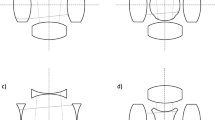Abstract
The current trend in constructing high-end computing systems consists of parallelizing large numbers of processors. A similar trend is observed in digital imaging where multiple camera inputs are utilized to obtain multiple images of a scene and thus enhance the performance envelope of the image capture. A methodology based on Voronoi diagrams is presented for coverage analysis of multi-camera systems mounted on spherical geometry. Interconnected network of camera concept is introduced for the purpose of the application development of multi-camera systems.
Access this chapter
Tax calculation will be finalised at checkout
Purchases are for personal use only
Similar content being viewed by others
References
Afshari, H., Jacques, L., Bagnato, L., Schmid, A., Vandergheynst, P., Leblebici, Y.: Hardware implementation of an omnidirectional camera with real-time 3d imaging capability. In: 3DTV Conference: The True Vision - Capture, Transmission and Display of 3D Video (3DTV-CON), pp. 1–4 (May 2011)
Burkard, R.E., Karisch, S., Rendl, F.: Qaplib-a quadratic assignment problem library. European Journal of Operational Research 55(1), 115–119 (1991)
Dally, W., Towles, B.: Principles and Practices of Interconnection Networks. Morgan Kaufmann Publishers Inc., San Francisco (2003)
Levoy, M., Hanrahan, P.: Light Field Rendering. In: SIGGRAPH 1996, Proceedings of the 23rd Annual Conference on Computer Graphics and Interactive Techniques, pp. 31–42. ACM (1996)
Author information
Authors and Affiliations
Editor information
Editors and Affiliations
Rights and permissions
Copyright information
© 2012 Springer-Verlag Berlin Heidelberg
About this paper
Cite this paper
Afshari, H., Seyid, K., Schmid, A., Leblebici, Y. (2012). Design and Implementation of Multi-camera Systems Distributed over a Spherical Geometry. In: Cox, P., Plimmer, B., Rodgers, P. (eds) Diagrammatic Representation and Inference. Diagrams 2012. Lecture Notes in Computer Science(), vol 7352. Springer, Berlin, Heidelberg. https://doi.org/10.1007/978-3-642-31223-6_31
Download citation
DOI: https://doi.org/10.1007/978-3-642-31223-6_31
Publisher Name: Springer, Berlin, Heidelberg
Print ISBN: 978-3-642-31222-9
Online ISBN: 978-3-642-31223-6
eBook Packages: Computer ScienceComputer Science (R0)




